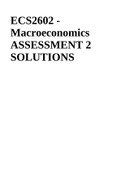ECS2602 -
Macroeconomics
ASSESSMENT 2
SOLUTIONS
, MACROECONOMICS - ECS260-2
SEMESTER 1 – 2022
ASSIGNMENT 2
UNIQUE NUMBER 774200
This assignment contributes 40% towards your semester mark. Please ensure that this assignment reaches the
university before the due date. Answer all questions on a mark-reading sheet.
1. Which of the following are fully exogenous variables in the IS-LM model?
1. Level of output, interest rate, investment, consumption spending.
2. Government spending, taxation, money supply, marginal propensity to consume.
3. Interest rate, demand for money, supply of money.
4. Consumption spending, investment, government spending.
Explanation
Government spending and money supply are the factors that are regarded as exogenous variables in the IS-LM model.
The level of output and income, the interest rate and investment spending are endogenous variables in the IS-LM
model.
2. Which of the following statements regarding investment spending in the IS-LM model is/are correct?
a. The interest rate is the cost of borrowing money, expressed as a percentage, usually over a period of one year. An
increase in the cost of borrowing money causes households and firms to borrow less money.
b. An increase in the level of output increases investment spending in the economy.
c. A decrease in the interest rate increases investment spending.
d. An increase in investors’ confidence increases investment spending.
1. a, b, c and d
2. Only a, b and c
3. Only b, c and d
4. Only b and c
5. Only d
Explanation
3. In the event of a rise in the interest rate a(n) _________ an investment curve takes place while an increase in
output will cause a(n) ________ an investment curve.
1. rightward shift of; downward movement along
2. downward movement along; rightward shift of
3. upward movement along; leftward shift of
4. upward movement along; rightward shift of
5. downward movement along; upward movement along
Explanation
In the event of a rise in the interest rate an upward movement along an investment curve takes place while an increase
in output will cause a rightward shift of an investment curve.
Page 1 of 22
, 4. Assume the interest rate increases when deriving the IS curve. In the goods market model, if the interest rate
increases …
1. government spending increases, the demand for goods increases and the equilibrium level of income rises.
2. investment spending decreases which decreases the demand for goods and the equilibrium level of output and income
falls.
3. investment spending increases which increases the demand for goods and the equilibrium level of income rises.
4. taxation decreases, disposable income of households increases which increases the demand for goods, and the
equilibrium level of income rises.
Explanation
When deriving the IS curve we assume a change in the interest rate. In this case, the interest rate increases. A
negative relationship exists between the interest rate and investment spending. The chain of events will look as
follows: i↑ → I↓ → Z↓ → Y↓.
5. Which of the following statements is/are correct regarding the derivation of the IS curve?
a. To derive the IS curve, we change the interest rate to determine the effect on the level of income.
b. To derive the IS curve, we change the level of output and income to determine the effect on the interest rate.
c. The IS curve represents combinations of output and interest rates where the financial market is in equilibrium, given
that all autonomous variables are unchanged.
d. The IS curve represents combinations of output and interest rates where the goods and financial markets are in
equilibrium, given that all autonomous variables are unchanged.
1. None of the statements is correct
2. Only a
3. Only b
4. Only c
5. a and d
Explanation
Statements a) and d) are correct. To derive the IS curve, we change the interest rate to determine the effect on the
level of income. The IS curve represents the combinations of output and the interest rate where the goods market is in
equilibrium.
6. Which of the following statements are correct?
a. The steepness of the IS curve depends on the interest sensitivity of investment spending and the output and income
sensitivity of investment spending.
b. The interest rate sensitivity of investment spending measures how sensitive investment spending is to a change in the
output and income.
c. The output sensitivity of investment spending measures how sensitive investment spending is to a change in output
and income.
d. If investment spending is not very sensitive to a change in the interest rate, a given change in the interest rate will have
a greater impact on investment spending and, consequently, the greater the change in the level of output and income
will be.
e. The flatter the IS curve the more sensitive is investment spending to a change in the level of output and income.
1. a, c and e
2. a, c, d and e
3. Only c and e
4. b, d and e
5. Only a and c
Page 2 of 22




